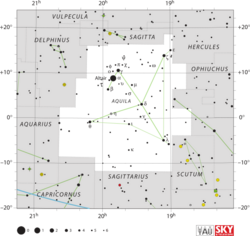Astronomy:31 Aquilae
| Observation data Equinox J2000.0]] (ICRS) | |
|---|---|
| Constellation | Aquila |
| Right ascension | 19h 24m 58.20027s[1] |
| Declination | +11° 56′ 39.8862″[1] |
| Apparent magnitude (V) | 5.16[2] |
| Characteristics | |
| Spectral type | G8 IV[2] |
| U−B color index | +0.42[3] |
| B−V color index | +0.77[2] |
| Astrometry | |
| Radial velocity (Rv) | –100.5[4] km/s |
| Proper motion (μ) | RA: +721.02[1] mas/yr Dec.: +642.49[1] mas/yr |
| Parallax (π) | 65.89 ± 0.26[1] mas |
| Distance | 49.5 ± 0.2 ly (15.18 ± 0.06 pc) |
| Absolute bolometric magnitude (Mbol) | 4.01[5] |
| Details | |
| Mass | 1.16 ± 0.07[5] M☉ |
| Radius | 1.379 ± 0.042[6] R☉ |
| Luminosity | 1.904 ± 0.045[6] L☉ |
| Surface gravity (log g) | 4.18 ± 0.03[5] cgs |
| Temperature | 5,510 ± 90[2] K |
| Metallicity [Fe/H] | +0.37[7] dex |
| Age | 4.5 ± 0.2[5] Gyr |
| Other designations | |
| Database references | |
| SIMBAD | data |
31 Aquilae (abbreviated 31 Aql) is a star in the equatorial constellation of Aquila. 31 Aquilae is its Flamsteed designation though it also bears the Bayer designation b Aquilae. This star has an apparent visual magnitude of 5.16 and is 49.5 light years from Earth. It has no known companions.
Properties
31 Aquilae has an apparent visual magnitude of 5.16,[2] making it bright enough to be seen with the naked eye in dark skies. The annual parallax shift of 65.89 mas[1] yields a distance estimate of 49.5 light-years (15.2 parsecs) from Earth. It is a variable star with a magnitude change of less than 0.02.[5]
With a stellar classification of G8 IV,[2] the luminosity class of IV indicates this is a subgiant star. Compared to the Sun, it has 116%[5] of the mass and 138%[6] of the radius. It is radiating nearly double[6] the luminosity of the Sun from its outer atmosphere at an effective temperature of 5,510 K,[2] giving it the yellow hue of a G-type star.[9] Its age is probably similar to NGC 188, the oldest open cluster known, which was calculated to be over 5 billion years. For its age, it is surprisingly rich in elements other than hydrogen or helium, contrary to common assumptions that the oldest stars should be metal-poor.
No certain substellar companion has been detected so far around 31 Aquilae. McDonald Observatory team has set limits to the presence of one or more planets [10] around 31 Aquilae with masses between 0.22 and 1.9 Jupiter masses and average separations spanning between 0.05 and 5.2 Astronomical Units.
Optical companions
The following stars are optical companions that are coincidentally aligned near the line of sight to 31 Aquilae.
| Companion | HD 231345 | BD+11 3833C |
|---|---|---|
| Right ascension | 19h 24m 51.8595s | 19h 24m 50.8s |
| Declination | +11° 57′ 14.692″ | +11° 57′ 36″ |
| Magnitude | 8.56 | 10.6 |
| Spectral type | G0 | |
| Reference | Simbad | Simbad |
References
- ↑ 1.0 1.1 1.2 1.3 1.4 1.5 van Leeuwen, F. (November 2007), "Validation of the new Hipparcos reduction", Astronomy and Astrophysics 474 (2): 653–664, doi:10.1051/0004-6361:20078357, Bibcode: 2007A&A...474..653V.
- ↑ 2.0 2.1 2.2 2.3 2.4 2.5 2.6 Malagnini, M. L.; Morossi, C. (November 1990), "Accurate absolute luminosities, effective temperatures, radii, masses and surface gravities for a selected sample of field stars", Astronomy and Astrophysics Supplement Series 85 (3): 1015–1019, Bibcode: 1990A&AS...85.1015M.
- ↑ Johnson, H. L. et al. (1966), "UBVRIJKL photometry of the bright stars", Communications of the Lunar and Planetary Laboratory 4 (99): 99, Bibcode: 1966CoLPL...4...99J.
- ↑ Wielen, R. et al. (1999), "Sixth Catalogue of Fundamental Stars (FK6). Part I. Basic fundamental stars with direct solutions", Veroeffentlichungen des Astronomischen Rechen-Instituts Heidelberg (Astronomisches Rechen-Institut Heidelberg) 35 (35): 1, Bibcode: 1999VeARI..35....1W.
- ↑ 5.0 5.1 5.2 5.3 5.4 5.5 Trevisan, M. et al. (November 2011), "Analysis of old very metal rich stars in the solar neighbourhood", Astronomy & Astrophysics 535: A42, doi:10.1051/0004-6361/201016056, Bibcode: 2011A&A...535A..42T. See Table 13.
- ↑ 6.0 6.1 6.2 6.3 Boyajian, Tabetha S. et al. (February 2012), "Stellar Diameters and Temperatures. I. Main-sequence A, F, and G Stars", The Astrophysical Journal 746 (1): 101, doi:10.1088/0004-637X/746/1/101, Bibcode: 2012ApJ...746..101B. See Table 10.
- ↑ Soubiran, C. et al. (2008), "Vertical distribution of Galactic disk stars. IV. AMR and AVR from clump giants", Astronomy and Astrophysics 480 (1): 91–101, doi:10.1051/0004-6361:20078788, Bibcode: 2008A&A...480...91S.
- ↑ "* b Aql". SIMBAD. Centre de données astronomiques de Strasbourg. http://simbad.u-strasbg.fr/simbad/sim-basic?Ident=%2A+b+Aql.
- ↑ "The Colour of Stars", Australia Telescope, Outreach and Education (Commonwealth Scientific and Industrial Research Organisation), December 21, 2004, http://outreach.atnf.csiro.au/education/senior/astrophysics/photometry_colour.html, retrieved 2012-01-16
- ↑ Detection Limits from the McDonald Observatory Planet Search Program
External links
- The Old Disk Metal-Rich Subgiant 31 Aquilae doi:10.1086/151065
- Image 31 Aquilae
- HR 7373
- CCDM 19249+1157
- R.A. Wittenmeyer et al., "Detection Limits from the McDonald Observatory Planet Search Program", The Astronomical Journal, Volume 132, Issue 1, pp. 177–188, May 2006.
 |


